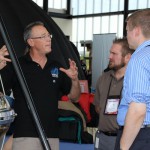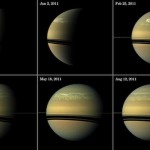Tag Space & astronomy
Massive storm pulls water and ammonia ices from Saturn’s depths
Now, thanks to near-infrared spectral measurements taken by NASA’s Cassini orbiter and analysis of near-infrared color signatures by researchers at UW–Madison, Saturn’s superstorm is helping scientists flesh out a picture of the composition of the planet’s atmosphere at depths typically obscured by a thick high-altitude haze.
With Ceres back in orbit, Planet Trek blasts off for the bike season
The Rodney Dangerfield of celestial bodies is back.
IceCube Neutrino Observatory reports first evidence for extraterrestrial high-energy neutrinos
A massive telescope in the Antarctic ice reports the detection of 28 extremely high-energy neutrinos that might have their origin in cosmic sources. Two of these reached energies greater than 1 petaelectronvolt (PeV), an energy level thousands of times higher than the highest energy neutrino yet produced in a manmade accelerator.
Experience the South Pole in Madison with an exploration of sound, light and images
Deep in the Antarctic ice, more than 5,000 detector modules sit in frozen darkness, waiting for the blue bursts of radiation released by particle interactions. Optimized to detect signs of neutrinos - tiny, nearly massless particles that can travel from the edges of the universe - these basketball-sized detectors comprise the IceCube Neutrino Observatory, one of the biggest astrophysics projects in the world.
International astrophysics reaches Milwaukee
Trips to the South Pole usually require a lot of specialized equipment, but Nils Irland's packing list for his November 2012 visit included some items unusual even by those standards: a specially designed video camera, extra batteries, and lots and lots of data storage.
Puzzle of how spiral galaxies get their arms comes into focus
Despite their common morphology, how galaxies like ours get and maintain their characteristic arms has proved to be an enduring puzzle in astrophysics. How do the arms of spiral galaxies arise? Do they change or come and go over time?
Badgers eager for chance to blast off into space
It’s no secret that Badgers excel in everything from sports to science, finance to fashion. Now, two UW–Madison alumni have hopes of bringing Badger pride to outer space.
Speakeasy Science: Space Place tees up science for grown-ups
Line up your baby sitter for the evening of Friday, March 8, and lift off for a night of fun and science at UW–Madison’s Space Place for the first edition of Speakeasy Science.
Botany experiment will try out zero gravity aboard space station
Gravity: It's the law in these parts. But to reach the stars, humans may have to learn to live outside the law.
‘Bringing the Universe to Wisconsin’ begins at UW–River Falls
It took seven years and the efforts of an international collaboration of scientists to turn the South Pole ice into the world's largest, most innovative telescope: the IceCube Neutrino Observatory.
Keck observations bring weather of Uranus into sharp focus
In 1986, when Voyager swept past Uranus, the probe's portraits of the planet were "notoriously bland," disappointing scientists, yielding few new details of the planet and its atmosphere, and giving it a reputation as a bore of the solar system.
A Hubble Space Telescope original returns to Wisconsin
After a journey of some 535 million space miles, give or take, and years languishing in a cavernous government warehouse, one of the original scientific instruments aboard the Hubble Space Telescope has splashed down in Wisconsin.
Learn about science in Spanish at Explorando las Ciencias
Explorando las Ciencias, a popular Spanish-language science outreach event, will take place from 2 to 10 p.m. on Friday, June 22, at Warner Park in the Community Recreation Center and shelter at Warner Park, 1625 Northport Drive, and with the help of “Amigos en Azul,” a Madison police organization aimed at building partnerships in the city’s Hispanic community.
Transit of Venus a rare event
On the evening of Tuesday, June 5, the planet Venus will cross the disk of the Sun in what astronomers call a "transit."
Washburn telescope optics get 130-year checkup, cleaning
Bit by bit over the last two decades, the University of Wisconsin–Madison's iconic Washburn Observatory has been restored to its original sheen.
Astronomers discover how mysterious blue straggler stars stay young
Mysterious "blue stragglers" are old stars that appear younger than they should be: they burn hot and blue. Several theories have attempted to explain why they don't show their age, but, until now, scientists have lacked the crucial observations with which to test each hypothesis.







